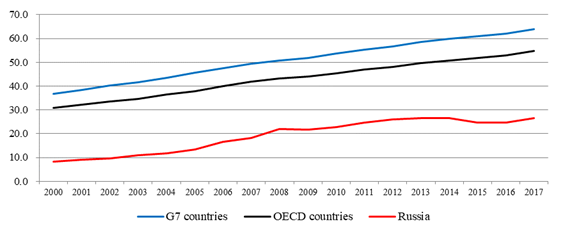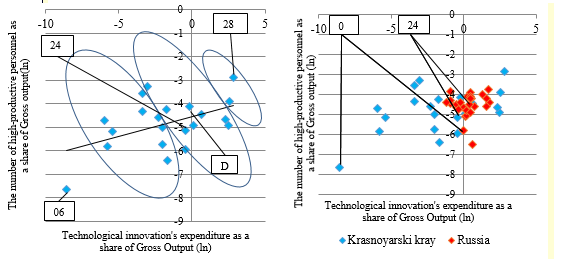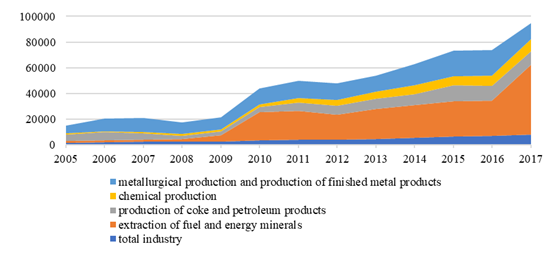Abstract
Awareness that high labour productivity provides long-term economic growth stimulates scholars and policymakers to focus on the productivity gap issue. Russia significantly underperforms in labour productivity, and the gap is increasing. In this paper we analyse technological intensity as the reason of the productivity gap. We used statistical data from the Russian region (Krasnoyarsk krai) with labour productivity that is slightly below the country's average. First, we grouped regional industries by the technological intensity. Then we compared technological intensity of the regional industries with the national level and found out that the main regional sectors underperform in technological development. Econometric analysis confirmed the influence of technological intensity on labour productivity only for high-technology industries of Krasnoyarsk krai. The group of medium-low and low technology industries don’t demonstrate significant correlation between productivity and research and development intensity (or simply R&D intensity). The most meaningful productivity driver for this group of industries is investment in capital assets. So the productivity growth in the main industries of regional economy depends on external technologies but not on R&D intensity of companies. Our study contributes to the productivity gap problem and provides evidence that technological intensity affects labour productivity of high-technology industries of regional economy.
Keywords: Economic activitieslabour productivityR&D intensityregional economy
Introduction
According to Nobel laureate Paul Krugman, long-term living standards are largely dependent on labour productivity (Krugman, 1994). Therefore, studying the causes of differences in labour productivity between countries and regions is one of the most important foci of economic science (Tang & Wang, 2004; Castellani, Piva, Schubert, & Vivarelli, 2019). Among the factors that determine cross-country and inter-regional differences in productivity, investment in physical (Holtz-Eakin, 1992) and human capital (McGowan & Andrews, 2015; Goffe & Monusova, 2017), the quality of company management (Bloom, Mahajan, McKenzie, & Roberts, 2010), as well as the level of technological development of enterprises, as measured by the intensity of research and development costs (Ugur, Trushin, Solomon, & Guidi, 2016). Previous studies conducted at the micro level have proven the positive effect of R&D intensity on productivity, especially for high-tech firms (Kancs & Siliverstovs, 2012). This article is devoted to the study of the influence of the level of technological intensity of industries on labour productivity in one of Russia’s most economically developed regions – Krasnoyarsk krai.
Problem Statement
The Russian Federation lags behind the leading countries of the world in terms of labour productivity and, despite productivity growth in recent years, the gap continues to widen (Figure

At the same time, the difference between Russia and the leading countries of the world in terms of per capita GDP is not as great as in labour productivity: while in per capita GDP of Russia is 1.72 times behind the OECD countries, the gap in productivity is more than double (Table
Such a gap may be due to a lag in the technological development of Russian industries. Thus, previous studies have shown that most sectors of the Russian economy in terms of R&D intensity fall into low- and medium-tech groups (Kotsyubynsky, 2015). To prove the hypothesis about the influence of technological intensity on labour productivity, we propose to study the case of one of the Russian regions, the labour productivity of which is at a slightly lower level than the average estimates made by the Organization for Economic Cooperation and Development (OECD) for Russia. Krasnoyarsk krai is an industrially developed Russian region, occupying the 8th place in the country in terms of GRP. However, labour productivity, calculated as the ratio of the region's GRP to the actual hours worked, amounted to $25 in 2017.
Research Questions
In our study, we compare the level of technological development of the leading industries of Krasnoyarsk krai with the country's average level, and also analyse the factors affecting labour productivity by industry.
Purpose of the Study
The purpose of our study is to assess the level of technological development of the leading industries of the Russian region and to determine the impact of technological intensity on labour productivity in the industry context.
Research Methods
The first part of our study is devoted to the classification of industries of Krasnoyarsk krai according to their level of technological intensity. The Organization for Economic Co-operation and Development (OECD) uses the R&D indicator of intensity to classify industries according to their technological level. This indicator is calculated as the ratio of R&D costs to gross value added. However, two reasons led us to abandon this indicator. Firstly, many high-performance firms, not being leaders in research and development, are successfully adapting the existing technologies. Secondly, the official body of state statistics of Russia – the Federal Agency for State Statistics – does not publish data on domestic expenditures on research and development by industry. Therefore, to determine the technological intensity of the industries of Krasnoyarsk krai, we used the ratio of the cost of technological innovations to gross output. The costs of technological innovation include the costs of developing new products, services, the purchase of machinery and equipment related to technological innovation, the purchase of new technologies, etc. That is, this indicator better reflects the level of technological intensity of the industry than the indicator of R&D costs.
Next, we performed an analysis of labour productivity in the industries of Krasnoyarsk krai for 2005-2017. Given the availability of statistical information, as an indicator of labour productivity, we used the amount of products shipped per employee in the industry. To ensure comparability of the data of long series, all the indicators calculated in the study for 2017 were reduced to the industry classification used in statistics for 2005-2016.
For each industry, linear Pearson correlation coefficients between labour productivity and indicators were calculated: (a) costs of technology innovations; (b) the amount of shipped innovative products; (c) fixed investments; (d) the average nominal accrued salary.
Findings
Krasnoyarsk krai is an industrially developed subject of the Russian Federation with a predominance of the non-ferrous metallurgy industry (41% of gross output), oil and gas production (21%) and electricity supply (9%). Figure
Comparison of the same industries with the national average shows the lag of sectors of Krasnoyarsk krai in terms of manufacturability (Figure

To clarify the hypothesis about the impact costs on technological innovations have on labour productivity in regional industries, we turn to the analysis of labour productivity data.
A general analysis of the labour productivity indicator by industries of Krasnoyarsk krai showed that only four of the seventeen sectors analysed act as the growth drivers: labour productivity is significantly higher than the industry average in the region (Figure
During the study period, the gap between labour productivity in the leading industries and the industry average of the region widened, which indicates a progressive growth of leading industries and stagnation of labour productivity in other sectors. Of all the leading industries in terms of productivity, two are systemically important – metallurgy and extraction of fuel and energy minerals. Both of these industries, as shown above are not technologically developed and are mainly oriented towards the manufacturing of products from the first stages. Labour productivity in two leading industries belonging to the high-tech medium-technology segment – chemical and oil refining industries – demonstrates cumulative dynamics of decline.

Thirteen industries of Krasnoyarsk krai in terms of labour productivity are below average. Out of these, in five sectors labour productivity is less than 30% of the region’s average industry (pulp and paper industry, mechanical engineering, transport engineering, electrical equipment, textile industry), in the extraction of non-mineral raw materials, which are mainly produced in the region by non-ferrous metal mining, productivity approaching the industry average, in other industries this figure is 40-60% of the average.
Correlation analysis of labour productivity indicator showed different types of dependencies for groups of industries that differ in types of technological development (Table
1. In almost all industries, there is a strong dependence of the level of salaries of workers on the result – which is labour productivity. In leading industries, this is less evident: their surplus product is mainly withdrawn in the form of profit and natural rent.
2. In industries with a higher level of technological development, the relationship between labour productivity and enterprise costs for technological innovation is more pronounced, which confirms the validity of the thesis about the positive impact of technological intensity on productivity, including for the Russian resource region. However, for less technologically intensive industries this dependence is not significant, and for individual industries it is not even the opposite (for example, for the “Production of machinery and equipment” industry).
3. The relationship between labour productivity and the rate of shipped innovative products is sporadically manifested in all groups of industries. There is a tendency to a general weakening of relations as the degree of technological development of the industry decreases.
4. Technologically developed industries are characterized by a lesser dependence on investment in fixed assets, while for most of the industries included in the group of medium-tech industries of low level, it is high. This connection is especially evident in the backbone industries for the region’s economy.
Conclusion
The main hypothesis of our study on the influence of technological intensity on labour productivity was confirmed only for the most technologically advanced industries of the region. Whereas the less technological sectors of industry, having high absolute values of productivity, did not show a positive relationship between the level of manufacturability and labour productivity. It is industries with a low level of technological development that form the basis of the region’s economy, providing positive dynamics of labour productivity in industry. Productivity in these sectors is more dependent on investments in fixed (physical) capital than on the quality of human capital or investments in technological innovations. Drivers of technological development in Krasnoyarsk krai and, possibly, other similar resource regions should be medium-technology high-level industries, leading in labour productivity. These industries are highly dependent on investments in innovations, while their contribution to general industrial production is significant; they have the resources to move to a new technological level.
Acknowledgments
The reported study was funded by Krasnoyarsk Regional Fund of Science according to the research project: “Methodology of labour productivity growth drivers analysis in resource regions of the Russian Federation under the conditions of the transition to a new path of technological development and implementation of the national project “Labour productivity and employment support” on the example of Krasnoyarsk krai”.
References
- Bloom, N., Mahajan, A., McKenzie, D., & Roberts, J. (2010). Why do firms in developing countries have low productivity? American Economic Review, 100(2), 619-623.
- Castellani, D., Piva, M., Schubert, T., & Vivarelli, M. (2019). R&D and productivity in the US and the EU: Sectoral specificities and differences in the crisis. Technological Forecasting and Social Change, 138, 279-291.
- Goffe, N., & Monusova, G. (2017). Proizvoditelnost truda: socialno-ekonomicheskie predposylki rosta [Labor Productivity: Socio-Economic Prerequisites for Growth]. Mirovaya ekonomika i mezhdunarodnye otnosheniya, 61(4), 37-49. [In Russ.].
- Holtz-Eakin, D. (1992) Solow and the States: Capital Accumulation, Productivity and Economic Growth. National Bureau of Economic Research Working Paper, No. w4144. Retrieved July 25, 2019, from https://papers.ssrn.com/sol3/papers.cfm?abstract_id=385901
- Kancs, D. A., & Siliverstovs, B. (2012). R&D and Non-Linear Productivity Growth of Heterogeneous Firms. KOF Working Papers No. 315. Retrieved July 25, 2019, from https://papers.ssrn.com/sol3/papers.cfm?abstract_id=2279383
- Kotsyubynsky, V. A. (2015). Metodologicheskie podhody sopostavleniya pokazatelej razvitiya vysokotekhnologichnyh sektorov Rossii i stran OESR [Methodological approaches for comparing development indicators of high-tech sectors of Russia and OECD countries]. Innovacii, 4(198), 27-32. [in Russ.].
- Krugman, P. (1994). The Age of Diminished Expectations. Cambridge MA: MIT Press.
- McGowan, A. M., & Andrews, D. (2015). Labour Market Mismatch and Labour Productivity: Evidence from PIAAC Data. OECD Economics Department Working Papers, No. 1209. Retrieved on August 5, 2019, from
- Organisation for Economic Co-operation and Development. (2017). Retrieved April 15, 2019, from https://stats.oecd.org/Index.aspx?DataSetCode
- Tang, J., & Wang, W. (2004). Sources of aggregate labour productivity growth in Canada and the United States. Canadian Journal of Economics, 37(2), 421-444.
- Ugur, M., Trushin, E., Solomon, E., & Guidi, F. (2016). R&D and productivity in OECD firms and industries: A hierarchical meta-regression analysis. Research Policy, 45(10), 2069-2086.
Copyright information

This work is licensed under a Creative Commons Attribution-NonCommercial-NoDerivatives 4.0 International License.
About this article
Publication Date
31 December 2019
Article Doi
eBook ISBN
978-1-80296-076-1
Publisher
Future Academy
Volume
77
Print ISBN (optional)
-
Edition Number
1st Edition
Pages
1-1056
Subjects
Industry, industrial studies, project management, sustainability, business, innovation
Cite this article as:
Gorodilov, V. M., Popodko, G. I., Zimnyakova*, T. S., & Samusenko, S. A. (2019). Labour Productivity And Technological Intensity In A Russian Region. In I. O. Petrovna (Ed.), Project Management in the Regions of Russia, vol 77. European Proceedings of Social and Behavioural Sciences (pp. 714-721). Future Academy. https://doi.org/10.15405/epsbs.2019.12.05.87
